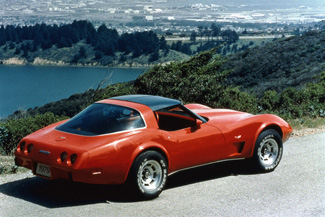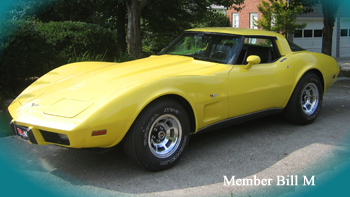As printed in For Vettes Only in October 1978.
 The 26th edition of the Corvette marks 1979 as a year of refinement. The more dramatic changes that celebrated last year's 25th anniversary of the Corvette are continued, most notably the aero-dynamic fastback coupe. The roof panel and rear window moldings are going to be black, but there will be little other exterior change, except that the 25th anniversary emblems, front and rear, will be replaced by the traditional "Cross Flags". After all, when the party's over, you take down the decorations.
The 26th edition of the Corvette marks 1979 as a year of refinement. The more dramatic changes that celebrated last year's 25th anniversary of the Corvette are continued, most notably the aero-dynamic fastback coupe. The roof panel and rear window moldings are going to be black, but there will be little other exterior change, except that the 25th anniversary emblems, front and rear, will be replaced by the traditional "Cross Flags". After all, when the party's over, you take down the decorations.It was a fine party, another successful year for the only sports car made for American tastes. The Corvette could well be the most successful car in American history. The demand for it continues unabated year after year. That's amazing when you consider how fickle the buying public can be and how short-lived the popularity of so many successful models has been. The Corvette as it enters its second 25 years is an American institution.
After a good party, you usually have your mind on comfort, especially if you’ve partied hard. Interior comfort is one of the main concerns of the 1979 Corvette. The highback bucket seats, introduced with the Limited Edition in mid-1978, are standard. The seats have a modern competitive look, which is after all, exactly what the Corvette is all about. The seats have deep poly foam cushions and high side bolsters for comfort and support. (Well, when you’ve got a car that you just love to be in, comfort is very important.) When the cloth and leather interior is ordered, a new cloth pattern replaces last year’s ribbed material.
The new standard bucket seats include a high pivot point that allows the seat back to fold down level with the luggage area load floor. This makes access to the luggage area easier, and the folded seat back on the passenger side can be used as an extension of the load floor.
For the drivers who have never learned to start a car that doesn’t have a radio (“let’s see now, first you put the key in, then you turn on the radio, tune in the station, check your hair in the mirror…etc.”)-there’s good news! The AM/FM radio is standard equipment in 1979. Good idea, G.M.! The car without a radio must be on the endangered species list.
Some of the new options for 1979 include heavy-duty shock absorbers for better ride control, high intensity high-beam headlamps, an illuminated visor mirror (essential to starting the Corvette at night?) and an AM/FM stereo radio with cassette player. Mid-1978 addition to the options list of transparent roof panels, power door locks and dual rear stereo radio speakers are continued for 1979. AND – at the time of this writing, there is no truth to the rumor that an optional power jet stream Jacuzzi is on the drawing boards.
There have been some changes in the heart of the 1979 Corvette too. The 5.7 litre base engine has increased horse power, torque and cold engine drivability. Nothing drastic, just careful refinements made with an eye toward performance. The major refinement incorporates high-performance type dual snorkel intakes for the air cleaner to improve engine breathing, horsepower, and torque. Also aiding engine output is a larger diameter “Y” pipe behind the emissions converter and new open-flow mufflers to reduce exhaust gas back pressure. Cold engine operation is improved with the trapped vacuum spark advance system and drivability is enhanced with a new exhaust gas recirculation (EGR) system.
When the 1979 Corvette is equipped with the automatic transmission, the axle ratio will be 3:55, from last year’s 3:08. The result of this change is more responsive performance. The manual transmission equipped Corvette now uses the same base shock absorbers as automatic transmission models, for a more comfortable ride.
It’s not earth shaking, but certainly part of the never ending struggle by G.M. engineers to overcome the pervasive regulations and requirements and still put a real Corvette on the market. You have to give them credit, they’ve succeeded so far, though the next few years may turn a few heads gray over the corporate world headquarters.
There is a rumor that two-tone paint schemes, similar to the way they did the silver anniversary and Pace car, will be an option for 1979. So far it is still a rumor, but it would be a nice touch.
Well, there it is: the 1979 Corvette. A refinement in performance, handling and interior comfort, ready to take on the challenge of another 25 years. We can all look forward to the next big bash – the semi-centennial Corvette.
’79 VETTE FACTS
|
|
|
VEHICLE IDENTIFICATION NUMBER
|
Numbered 1Z87[ ]9S400001 to 1Z87[ ]9S453807. The first symbol 1 indicated Chevrolet. The second symbol identified the body series Z. The third and fourth symbols indicate the boby style number 87=Coupe. The fifth symbol [inb blank] indicates engine: 8=350-cid 195-hp V-8; 4=350-cid 225-hp V-8. The sixth symbol indicates the model year 9=1979. The seventh symbol identifies the assembly plant S = Saint Louis. The last six symbols indicate the sequential production number.
|
|
ENGINE
|
BASE ENGINE
Type: V-8
Bore and stroke: 4.00 x 3.48 in.
Displacement: 350 cid
Brake hp: 195at 4000 rpm.
Induction: Rochester M4MC
OPTIONAL ENGINES:
350-cid/225-hp w/Rochester M4MC
|
|
VITAL STATS
|
Coupe
Original Price: $10,220.23
Production: 53,807
Wheelbase: 98 in.
Length: 185.2 in.
Tires: P225/70R-15 SBR
|
|
COOL STUFF
|
• Vin number is stamped on a plate on the inner vertical surface of the left windshield pillar visible through the windshield.
• Front & rear spoilers develped as part of the 1978 Pace Car package became 1979 option D80 ($265).
|